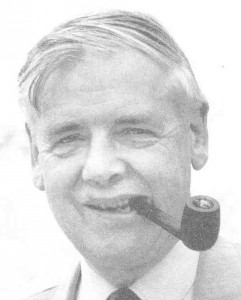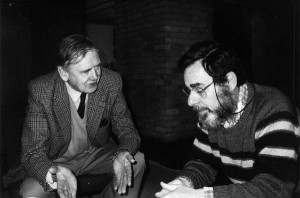
Have you ever heard about John Michael Hammersley (1920-2004)? May be not. Hammersley was an eccentric British mathematician who contributed to probability theory at large.
Hammersley studied in Cambridge, and participated, as many others, to the British efforts during the second world war: ``[...] Finally in 1942 I was transferred to the Trials Wing at Lydstep. Amongst the personnel at Trials Wing there was a team of about 40 girls who carried out the computations necessary for analyzing the performance of the anti-aircraft equipment, and I was responsible for directing their calculations. One of their jobs consisted in operating the kinetheodolites for tracking a target. The kinetheodolites were a pair of synchronized telescopic cameras at each end of a base line about a couple of miles long, which could give simultaneous readings of the respective angles to a target (either an aircraft or a radar sleeve towed behind an aircraft). From the resulting data it was possible to compute fairly accurate positions of the target and how these positions depended upon time as the target moved along its flight path. In practice it was just an ugly piece of three-dimensional trigonometry; and when I first arrived at Lydstep it was done with pencil and paper with the aid of a 7-figure tables of trigonometric functions, in accordance with traditions of military surveyors. But while surveyors may conceivably be interested in determining a position to the nearest fraction of an inch, it was nonsense to do so for an aircraft target in view of the more dominant errors inherent in gunnery. One of my first reforms was simply to introduce 4-figure trigonometric tables, and to equip the computing room with desk calculating machines in place of longhand pencil and paper sums. The calculating machines were winkled out of the Treasury, who were keeping them massed in a big cupboard in case they might be of future service for financial purposes. [...]'', in John Michael Hammersley (1920-2004) by Grimmett and Welsh, 2006. Grimmett and Welsh are two former students of Hammersley. They also edited a volume in honor of Hammersley entitled Disorder in Physical Systems, originally published by Oxford University Press in 1990 (all rights gracefully returned to the authors by OUP in 2001).
Hammersley lived in England and in the US. He was an imaginative problem solver, one of these mathematicians who refused to split mathematics into pure mathematics and applied mathematics. He passionately and provocatively advocated the importance of problem solving and the analysis of concrete mathematical models, in opposition to the exclusive development of abstraction in Mathematics. Recall that this was a huge debate in the second part of the twentieth century, with structuralism, Nicolas Bourbaki, New Math, ...
In my humble opinion (blog author), there is no canonical way of doing Mathematics. I appreciate Harmmersley's arguments because he was fighting against an excess. Mathematics is more a creative art than a technological industry. We should leave each mathematician working using his or her own style, imagination, and tastes. This is of course difficult since the publication process involves evaluations by peers and thus human comedy. Mathematics are rich when both problem solvers and theory builders can work in parallel creatively and successfully. Many of them are complementary. Creativity is reduced if one imposes dogmas or constraints. I do believe that the value of works is only known years after their making.
Hammersley wrote several pioneering and influential works, for instance on the following:
- self-avoiding random walks and the monomer-dimer problem;
- percolation phenomenon (site and bond, critical probability, first passage percolation);
- (quasi-)Monte-Carlo simulation (Hammersley set and low-discrepancy sequences);
- graphical models and random fields (Clifford-Hammersley theorem);
- randomized combinatorial optimization (Travelling Salesman Problem);
- random polynomials (density of the roots).
Hammersley on the MathSciNet database (he published about 90 papers).
Hammersley took only eight PhD students. John Halton (known for Halton sequences) was one one them. He tells us how he was unusually recruited: ``A cousin drew my attention to an advertisement in the Observer..., seeking applicants for UKAEA Research Studentships, to study Monte Carlo methods for a DPhil at Oxford. . . . In a few weeks, I was invited to “present myself for examination” at the UKAEA site at Didcot. With very little idea of what this would entail, I went. There I found a [number of ] equally bemused applicants, who were ushered into a large hall furnished with a suitable number of small desks and sat down. John Hammersley strode breezily up to the podium, introduced himself, and asked us to write a four-hour examination, consisting of a dozen or so tough mathematical questions. I attempted to solve each problem in turn, suggested possible lines of approach, and tried to answer the questions posed, with little success. At the end of four hours, the papers were collected and we waited anxiously for the outcome.'', ibid.
